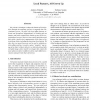Free Online Productivity Tools
i2Speak
i2Symbol
i2OCR
iTex2Img
iWeb2Print
iWeb2Shot
i2Type
iPdf2Split
iPdf2Merge
i2Bopomofo
i2Arabic
i2Style
i2Image
i2PDF
iLatex2Rtf
Sci2ools
CVPR
2006
IEEE
2006
IEEE
Local Features, All Grown Up
We present a technique to adapt the domain of local features through the matching process to augment their discriminative power. We start with local affine features selected and normalized independently in training and test images, and jointly expand their domain as part of the correspondence process, akin to a (non-rigid) registration task that yields a (multi-view) segmentation of the object of interest from clutter, including the detection of occlusions. We show how our growth process can be used to validate putative affine matches, to match a given "template" (an image of an object without clutter) to a cluttered and partially occluded image, and to match two images that contain the same unknown object in different clutter under different occlusions (unsupervised object detection).
Computer Vision | CVPR 2006 | Local Affine Features | Putative Affine | Unknown Object | Unsupervised Object Detection |
| Added | 12 Oct 2009 |
| Updated | 12 Oct 2009 |
| Type | Conference |
| Year | 2006 |
| Where | CVPR |
| Authors | Andrea Vedaldi, Stefano Soatto |
Comments (0)

